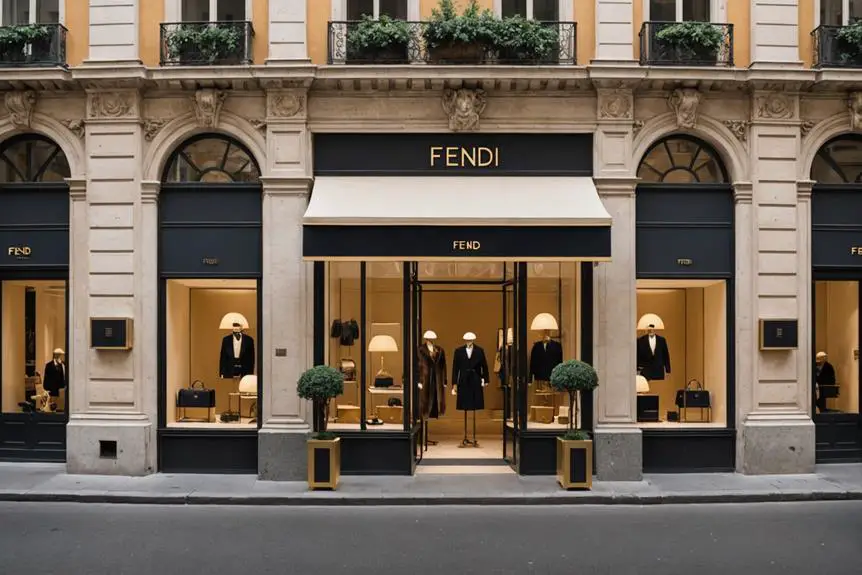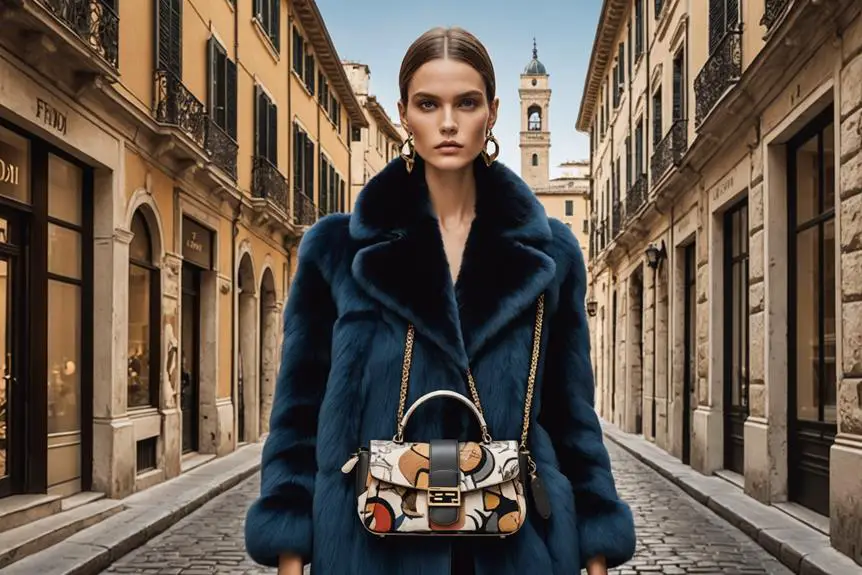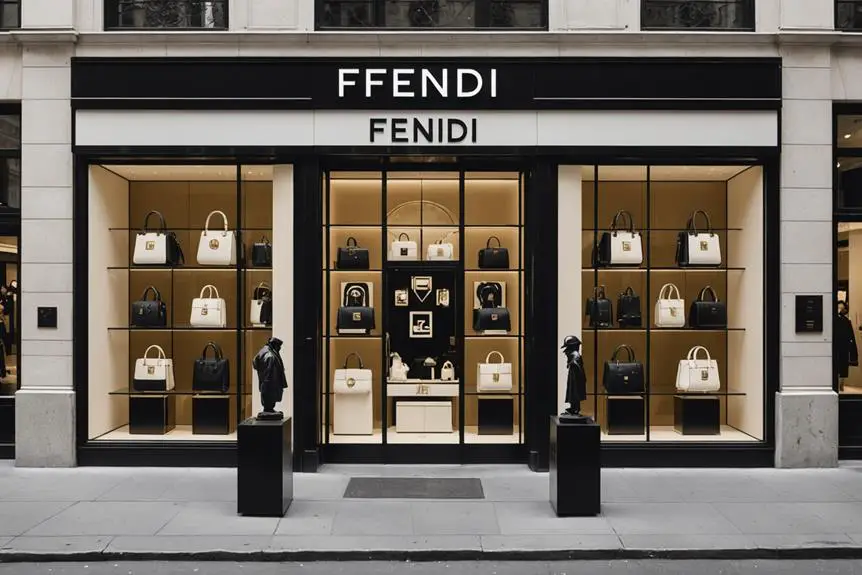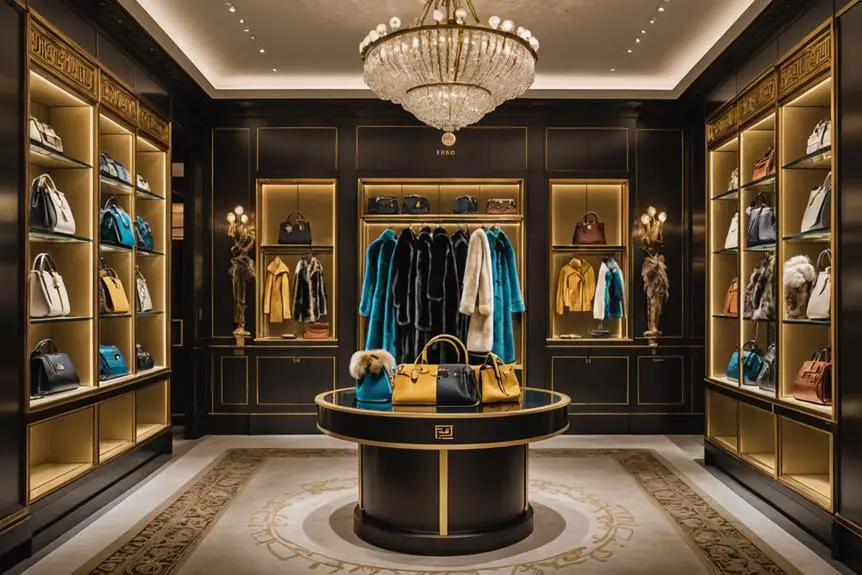When you explore the history of Fendi, you'll discover its beginnings in 1925, founded by Adele and Edoardo Fendi in Rome. Initially focused on leather goods, the brand flourished as the five Fendi sisters joined, each contributing unique skills to enhance the company's prestige. A pivotal moment came in 1965 when Karl Lagerfeld introduced the iconic double F logo, seamlessly blending tradition with a fashion-forward vision. With leadership changes over the years, including Kim Jones's appointment in 2020, Fendi continues to innovate while honoring its rich heritage. As you delve deeper, you'll uncover the brand's remarkable evolution and its significant impact on the luxury fashion landscape.
Origins of Fendi

When you explore the origins of Fendi, you'll discover a remarkable story that began in 1925 with the vision of Adele and Edoardo Fendi in Rome. They focused on luxury leather goods and fur, establishing a brand that would soon become synonymous with Italian elegance. In 1926, they opened their first boutique on Via del Plebiscito, quickly attracting a clientele that appreciated exceptional craftsmanship and unique designs. The brand's early identity was further solidified by the original logo, which featured a detailed illustration of a squirrel, reflecting Fendi's dedication to luxury and nature, as seen in vintage Fendi logos.
By the late 1940s and 1950s, the Fendi legacy expanded as their five daughters—Anna, Carla, Franca, Alda, and Paola—joined the family business, each bringing distinct skills that propelled Fendi's growth. Remarkably, the introduction of the Selleria line, inspired by horse bridles, showcased the brand's commitment to artisanal craftsmanship, setting a standard for handmade leather bags.
Through innovative designs and strategic collaborations, Fendi gained international recognition, transforming from a local boutique into a global luxury powerhouse. This evolution laid the foundation for a brand that continues to captivate fashion enthusiasts today, embodying the spirit of luxury and artisanal quality that Adele and Edoardo envisioned nearly a century ago.
Contributions of the Fendi Sisters
The Fendi sisters—Anna, Carla, Franca, Alda, and Paola—were instrumental in shaping the brand's identity and expanding its reach during the late 1940s and beyond. Each sister brought unique skills to the table, contributing to Fendi's legacy of luxury and craftsmanship. Anna focused on design and licensing, ensuring that Fendi's aesthetic remained innovative while being commercially viable. Carla enhanced brand visibility through her management of commercial operations and press relations, positioning Fendi as a household name in the luxury market.
Franca, as the purchasing manager, prioritized client relations, which was vital for maintaining high standards and customer satisfaction. Her efforts reinforced the brand's commitment to quality. Alda took charge of the atelier and fur workshop, playing a pivotal role in overseeing production quality and driving innovation in Fendi's fur collections. Meanwhile, Paola specialized in the fur segment, further solidifying the brand's reputation in this luxury market. Together, the Fendi sisters not only managed the business efficiently but also laid the groundwork for a legacy that continues to influence fashion today, proving that their combined talents were essential for the brand's sustained growth and prominence.
Design Innovations and Influences

Transforming luxury fashion through design innovations, Fendi has consistently pushed the boundaries of craftsmanship and creativity. Since Karl Lagerfeld joined as lead designer in 1965, the brand's identity has been defined by the iconic double F logo, which he introduced. Lagerfeld revolutionized the use of fur, shifting it from traditional garments to versatile materials featured in both luxury accessories and ready-to-wear collections. The launch of Fendi's first ready-to-wear collection in 1977 marked a pivotal moment, showcasing the brand's adaptability in a competitive market.
Silvia Venturini Fendi furthered this legacy by creating the groundbreaking Baguette bag in 1997—a cultural phenomenon that sold over 100,000 units in its debut year. In 2009, the introduction of the Peekaboo bag emphasized Fendi's commitment to innovative design and exceptional craftsmanship.
- Karl Lagerfeld's influence on the double F logo
- Transformation of fur collections into fashion staples
- Major impact of the Baguette bag on luxury accessories
- The significance of the Peekaboo bag in Fendi's portfolio
These innovations reflect how the Fendi family continues to shape the landscape of luxury fashion.
Leadership and Evolution
Since its inception, Fendi's leadership has been a demonstration of its adaptability and resilience in the luxury fashion industry. The appointment of Kim Jones as Artistic Director for Couture and Womenswear in 2020 marked a pivotal shift, being the first non-family leader since Karl Lagerfeld. This evolution reflects a blend of Fendi's rich heritage with contemporary fashion influences, as showcased in the Fall/Winter 2021 collection.
Silvia Venturini Fendi, overseeing Accessories and Menswear, has played an instrumental role in maintaining Fendi's legacy through iconic creations like the Baguette and Peekaboo bags. The Fendi sisters, who took control after their mother, Adele Casagrande Fendi, passed away in 1978, facilitated the brand's growth and innovation through their diverse business operations.
Today, Fendi is committed to preserving luxury and craftsmanship while embracing modern trends and sustainability practices. This dual focus not only honors the brand's storied past but also positions it for future success in an ever-evolving fashion landscape. The leadership at Fendi exemplifies a thoughtful balance between tradition and innovation, guaranteeing its place as a leading luxury fashion house.
Brand Presence and Resources

Fendi's brand presence is intricately woven into the fabric of luxury fashion, highlighting both its storied heritage and modern aspirations. The inauguration of its new headquarters at Palazzo della Civiltà Italiana in 2015 symbolizes Fendi's commitment to maintaining its luxury identity while honoring its rich history. Its flagship store in Rome, located at Largo Carlo Goldoni, serves as a major retail destination, featuring Fendi Suites—blending hospitality and fashion.
Fendi's market presence is bolstered by its iconic product offerings, like the Baguette and Peekaboo handbags, which have become synonymous with the brand. Through strategic collaborations with entities like Skims and Rimowa, Fendi enhances its global reach and visibility, ensuring it remains relevant in the ever-evolving luxury landscape.
To engage the next generation of fashion professionals, Fendi actively provides career resources that include free webinars and innovative job acquisition strategies, reflecting its dedication to nurturing talent.
- Headquarters at Palazzo della Civiltà Italiana
- Flagship store with Fendi Suites in Rome
- Iconic products like the Baguette
- Strategic collaborations expanding global reach
Frequently Asked Questions
What Is the Story Behind Fendi?
When you explore Fendi's story, you discover a blend of innovation, luxury, and family legacy. Their evolution reflects bold creative leadership and a commitment to craftsmanship, shaping the brand into a global fashion powerhouse.
Is Fendi Still Family Owned?
Fendi isn't fully family-owned anymore, as LVMH holds a majority stake. However, the Fendi family retains significant influence, ensuring their traditional values and innovative spirit continue to shape the brand's direction and identity.
What Are Some Interesting Facts About Fendi?
Fendi's innovative designs, like the iconic Baguette bag, revolutionized luxury fashion. Their commitment to cultural heritage is impressive, too; they've invested millions in restoring landmarks, showcasing a blend of artistry and responsibility that truly stands out.
Why Is Fendi so Popular?
Fendi's popularity comes from its innovative designs, commitment to quality, and iconic products. You appreciate their luxury craftsmanship, unique collaborations, and ability to adapt to trends, making Fendi a sought-after brand in contemporary fashion.





Cryptocurrency industry insights